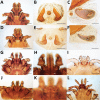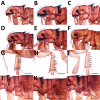Zoonotic Vectorborne Pathogens and Ectoparasites of Dogs and Cats in Eastern and Southeast Asia
- PMID: 32441628
- PMCID: PMC7258489
- DOI: 10.3201/eid2606.191832
Zoonotic Vectorborne Pathogens and Ectoparasites of Dogs and Cats in Eastern and Southeast Asia
Abstract
To provide data that can be used to inform treatment and prevention strategies for zoonotic pathogens in animal and human populations, we assessed the occurrence of zoonotic pathogens and their vectors on 2,381 client-owned dogs and cats living in metropolitan areas of 8 countries in eastern and Southeast Asia during 2017-2018. Overall exposure to ectoparasites was 42.4% in dogs and 31.3% in cats. Our data cover a wide geographic distribution of several pathogens, including Leishmania infantum and zoonotic species of filariae, and of animals infested with arthropods known to be vectors of zoonotic pathogens. Because dogs and cats share a common environment with humans, they are likely to be key reservoirs of pathogens that infect persons in the same environment. These results will help epidemiologists and policy makers provide tailored recommendations for future surveillance and prevention strategies.
Keywords: Southeast Asia; Zoonoses; cats; companion animals; dogs; eastern Asia; ectoparasites; parasites; pathogens; vector-borne diseases; vector-borne infections; vectors.
Figures






Similar articles
-
Disease Risk Assessments Involving Companion Animals: an Overview for 15 Selected Pathogens Taking a European Perspective.J Comp Pathol. 2016 Jul;155(1 Suppl 1):S75-97. doi: 10.1016/j.jcpa.2015.08.003. Epub 2015 Sep 28. J Comp Pathol. 2016. PMID: 26422413 Review.
-
Feline and canine leishmaniosis and other vector-borne diseases in the Aeolian Islands: Pathogen and vector circulation in a confined environment.Vet Parasitol. 2017 Mar 15;236:144-151. doi: 10.1016/j.vetpar.2017.01.019. Epub 2017 Jan 23. Vet Parasitol. 2017. PMID: 28288759
-
Zoonotic intestinal parasites and vector-borne pathogens in Italian shelter and kennel dogs.Comp Immunol Microbiol Infect Dis. 2017 Apr;51:69-75. doi: 10.1016/j.cimid.2017.04.003. Epub 2017 Apr 21. Comp Immunol Microbiol Infect Dis. 2017. PMID: 28504099
-
A serological survey of rural dogs and cats on the southwestern Canadian prairie for zoonotic pathogens.Can J Public Health. 2001 Jan-Feb;92(1):67-71. doi: 10.1007/BF03404848. Can J Public Health. 2001. PMID: 11257996 Free PMC article.
-
Arthropod-transmitted diseases of companion animals in Southeast Asia.Trends Parasitol. 2004 Jan;20(1):27-34. doi: 10.1016/j.pt.2003.11.004. Trends Parasitol. 2004. PMID: 14700587 Review. No abstract available.
Cited by
-
Ehrlichiosis in Dogs: A Comprehensive Review about the Pathogen and Its Vectors with Emphasis on South and East Asian Countries.Vet Sci. 2022 Dec 29;10(1):21. doi: 10.3390/vetsci10010021. Vet Sci. 2022. PMID: 36669021 Free PMC article. Review.
-
Zoonotic Dirofilaria sp. "hongkongensis" in subcutaneous nodules from dogs and cats, Hong Kong SAR.Parasit Vectors. 2024 Nov 15;17(1):469. doi: 10.1186/s13071-024-06544-7. Parasit Vectors. 2024. PMID: 39548498 Free PMC article.
-
Seroprevalence study in humans and molecular detection in Rhipicephalus sanguineus ticks of severe fever with thrombocytopenia syndrome virus in Thailand.Sci Rep. 2024 Jun 11;14(1):13397. doi: 10.1038/s41598-024-64242-x. Sci Rep. 2024. PMID: 38862576 Free PMC article.
-
Knowledge, attitude, and practices of veterinarians towards canine vector-borne pathogens in Sri Lanka.PLoS Negl Trop Dis. 2024 Jul 29;18(7):e0012365. doi: 10.1371/journal.pntd.0012365. eCollection 2024 Jul. PLoS Negl Trop Dis. 2024. PMID: 39074136 Free PMC article.
-
NexGard® Combo (esafoxolaner, eprinomectin, praziquantel), a new endectoparasiticide spot-on formulation for cats.Parasite. 2021;28:E1. doi: 10.1051/parasite/2021013. Epub 2021 Apr 2. Parasite. 2021. PMID: 33812448 Free PMC article. No abstract available.
References
MeSH terms
LinkOut - more resources
Full Text Sources
Miscellaneous

